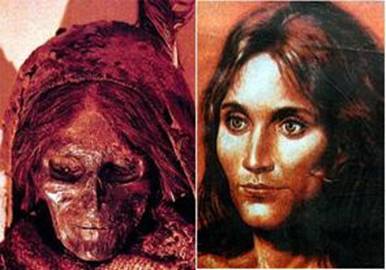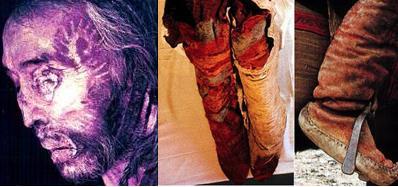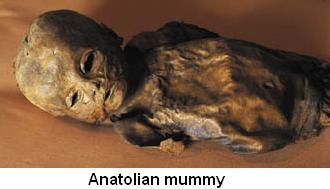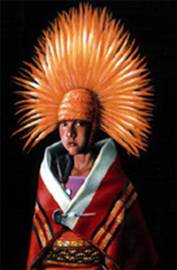|
People have heard a lot about ancient Egyptian mummies, but
few know that mummification has been practiced in other parts
of the world. Some bodies were treated for preservation and
buried with great care, but others became mummified because of
natural conditions where they were buried. We saw in Chapter
49, Tattooing Habits;
cases of natural mummification. Mummified people found in
Kurgans, located on high regions of the Altai Mountains, did
not die on these high places but were carried up and buried
for preservation. Kurgans were dug deep in the soil and a
special wooden chamber was built for the dead leader. Food
–meat in general- and drink was left within the burial chamber
next to the coffin and even a knife for cutting the meatloaf
was placed on a small table. Such precautions tell us that the
ancient Asiatic people believed in an afterlife and took great
care for preparing the necessary conditions for the person
–male or female- to exist after death has occurred. Embalming
and preserving the body was a treatment applied only to
special people such as tribe leaders and shamans. Such
special care meant that death was denied and that the person
would continue to exist beyond this material world.
The Xinjiang
(Sinjan) Uighur region of northwest China is a region where
many mummified bodies have been found. Archeologists claim
that the dry weather conditions were responsible for the
mummification of buried bodies. But considering that there was
a close cultural link between the Kurgan-building tribes of
the mountainous regions of Central Asia and the Uighur people
of the arid lowlands, we can conclude that similar care was
taken in the burial rites of important people of the Sinjan
region. One example is the so called “Loulan
Beauty”. Loulan is a presently deserted ancient
city of Sinjan which was once an important cultural center.
Below left we see the 3,800 year old mummy of the woman
nicknamed the Loulan Beauty. The feather recognizable on top
of her head tells us that she was most probably a shaman
woman. On the right side we see a reconstructed picture of
this Loulan lady.

Victor Mair, a specialist in the ancient corpses and co-author
of “Mummies of the Tarim Basin”,
(1)
said:
Modern
DNA and ancient DNA show that Turks, Uighurs, Kazaks, Krygyzs,
all people of Central Asia are all mixed Caucasian and East
Asian. The modern and ancient DNA tells the same story.
The facial
features of the Loulan Beauty are clearly Caucasoid, a clear
indication that the Eurasiatic people, who call themselves
“Europeans”, have Central Asiatic ancestry. Below we see the
mummified so called “Cherchen man” on the left and his boots
at the center. These boots are still used by Central Asiatic
riders as shown on the right side.

The body of the Cherchen man found in 1978, at a burial site
in East Turkistan, was immaculately preserved. This man who
lived about 3,000 years ago was most probably a shaman,
guessing from the sun marking (tattoo) on the left side of his
head. Most interestingly, the Cherchen Man was buried with no
less than ten hats, even a conical “witch” hat – which is
found as a common feature on several of these mummies. We saw
that the Saka (Scythians) also wear pointed hats (see Chapter
23,
The Issýk Kurgan).
Though it
was commonly believed that the first contact between East
Turkistan whose capital is Urumqi (Urumchi) and the West
occurred relatively late in world history — around the middle
of the second century B.C. — carbon dating has shown that the
Cherchen man died 900 years earlier, indicating a much early
expansion towards the west. The Uighur people who were expert
riders could populate remote regions of the world due to their
semi-nomadic lifestyle (see Chapter 24,
Horses for Eternity).
The culture
of mummification did not die out as these Asiatic people
spread in different directions. Today, one can still observe
22 mummies displayed in the museum of Amasya – Turkey
(2).
Below we see one the eight mummies belonging to the ruling
family of Amasya during the 14th century AD. There
is also a mummy found in Konya Karaman, which has been dated
to belong to a 17 year old girl who lived some 1,400 years
ago.

Mummification is also found among the Inca culture. All along
the Andean Mountains of Peru and Chile human mummies have been
discovered. Archaeologists discovered not long ago 26 burial
bundles (3),
each containing one or more adult and child mummies dating
from 1472 to 1532. Below we see the drawing of a young
mummified woman found in such a location. The headdress is a
clear representation of the sun, indicating that the Inca
people were sun-worshipers and the young woman was a
sacrificial offering to the sun-god.
 |